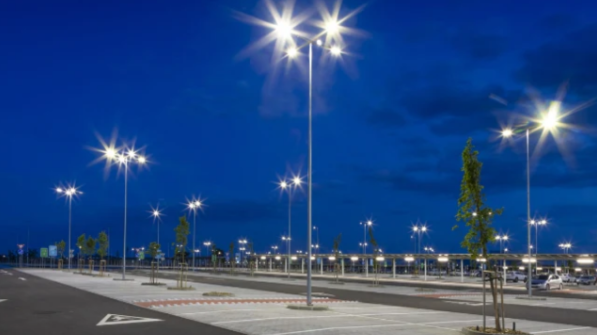
Parking lot lighting is an important part of urban infrastructure because it ensures safety, security, and visibility in outdoor spaces. Well-designed and well-maintained lighting systems contribute to a sense of comfort while also improving the overall functionality of parking spaces. However, typical problems might emerge, impairing the performance and dependability of parking lot lights. Understanding these issues is critical to maintaining ideal lighting conditions.
Common parking lot lighting difficulties include bulb and lamp failures, which result in frequent repairs and higher maintenance expenses. Dimming or flickering lights can impair sight and raise safety concerns, whereas irregular illumination might come from improper spacing or misaligned fixtures. Light pollution, caused by factors such as inadequate shielding and excessive brightness, creates environmental and optical comfort issues.
Corrosion and weather damage, pest infestations, and electrical concerns all add to the difficulty of maintaining dependable and efficient parking lot lighting. This article digs into these typical concerns, looking at the reasons, potential solutions, and prevention actions. By proactively resolving these issues, property owners may guarantee that their parking lots are well-lit, safe, and visually appealing to both drivers and pedestrians.
Why choose LED parking lot lights over traditional lighting?
Opting for LED parking lot lights over traditional illumination has numerous benefits. LED lights are well-known for their high energy efficiency, which converts more electricity into visible light and results in significant cost savings. LEDs have a lifespan of 50,000 to 100,000 hours, which considerably reduces maintenance and replacement costs. Their rapid light output guarantees fast illumination without warm-up periods, improving parking safety.
LED technology enables customized lighting solutions, allowing businesses and municipalities to customize brightness levels and color temperatures to individual requirements. Furthermore, LED lights are environmentally beneficial, producing fewer greenhouse gases and carrying no toxic elements such as mercury. The combination of energy efficiency, lifespan, adaptability, and environmental sustainability makes LED parking lot lights the clear choice, providing not only financial savings but also increased safety, visibility, and a lower environmental effect.
Common Parking Lot Lights Issues
Parking lot lights serve an important role in ensuring visibility, safety, and security in outdoor settings. However, like any other infrastructure, they are susceptible to a variety of difficulties that might impair their effectiveness. Understanding the common issues with parking lot lights, their core causes, and effective solutions is critical for property owners, managers, and maintenance professionals. This article delves into several prominent difficulties.
Bulb And Lamp Failures
Bulb and lamp failures are common in parking lot lights and are frequently attributable to aging bulbs, electrical faults, or low-quality components. The frequent replacement of standard bulbs, especially in high-pressure sodium or metal halide lights, increases maintenance costs and raises safety concerns. Property owners can address these difficulties by evaluating and replacing aging bulbs regularly, resolving electrical issues as soon as possible, and adopting higher-quality and longer-lasting LED retrofit solutions for increased durability and lower maintenance.
Dimming Or Flickering Lights
Dimming or flickering lights in parking lots can reduce visibility and endanger safety. Loose wiring, aging ballasts, poor-quality fixtures, and voltage swings are all possible causes. Solutions include examining and securing wire connections, replacing aging ballasts, upgrading to high-quality fixtures, and adding voltage regulators to handle variations. Addressing these concerns as soon as possible guarantees constant and reliable illumination, which improves the safety and visual appeal of parking lots.
Inconsistent Illumination
Inconsistent illumination, defined as uneven light dispersion in parking lots, provides a safety risk and diminishes overall efficacy. Common issues include insufficient fixture spacing, improperly designed layouts, and misaligned or obstructed fixtures. To address this issue, property owners should remodel lighting layouts, verify adequate fixture spacing, and reposition fixtures to provide uniform coverage. Using photometric studies during the design process aids in attaining exact placement for consistent and evenly dispersed illumination.
Light Pollution
Light pollution in parking lots, caused by issues such as improperly shielded bulbs, excessive brightness, and inappropriate light aiming, can have an impact on both visual comfort and environmental quality. Mitigation entails installing shielded lighting to direct light where it is needed, utilizing low-wattage lamps, and appropriately pointing lights downward to reduce upward light leakage. By addressing these issues, property owners help to provide well-lit parking areas while reducing the detrimental effects of light pollution on nearby locations.
Corrosion And Weather Damage
Corrosion and weather damage in parking lot lights are caused by exposure to harsh environments and insufficient protection. Rain, snow, salt, and low-quality protective coatings are all contributing factors. Solutions include installing weather-resistant coatings, cleaning regularly to remove corrosive substances, and investing in high-quality, corrosion-resistant fixture materials. These procedures maintain the lights’ structural integrity, assuring longevity while minimizing the visual and functional impact of weather-related degradation.
Pest Infestations
Pest infestations in parking lot lights, which are frequently caused by gaps in fixtures, debris collection, or a lack of deterrent measures, can disrupt functionality. To remedy this issue, property owners could close gaps, clean regularly to discourage nesting, and install pest deterrent devices or coatings. Property owners guarantee that parking lot lights continue to perform and function by keeping pests such as insects, birds, and rodents out of the fixtures.
Electrical Issues
Electrical problems with parking lot lights are widespread and can be caused by poor-quality wiring, water infiltration, and defective ballasts or drivers. To address these problems, property owners should inspect wiring and connections regularly, repair water ingress issues as soon as possible, and consider upgrading to high-quality, long-lasting electrical components. These procedures maintain the lighting system’s dependability and functionality, reducing the chance of flickering lights, breakdowns, and other electrical issues.
Read Also: Ventsfanzine
Final Words
Parking lot lights are critical to producing safe, secure, and well-lit settings. Property owners and managers may ensure that parking lot lighting systems function optimally, last longer, and are sustainable by identifying fundamental issues and implementing proactive remedies. Regular inspections, adherence to best practices, and consideration of advanced technology, such as LED retrofits, all help to create parking lots that are not only well-lit but also resistant to numerous issues.






